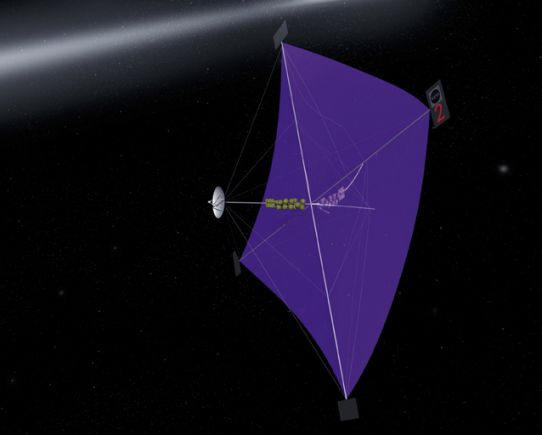Explanation: Could solar sailing become a future Olympic sport? Nearly 400 years ago astronomer Johannes Kepler observed comet tails blown by a solar breeze and suggested that vessels might likewise navigate through space using appropriately fashioned sails. It is now widely recognized that sunlight does indeed produce a force which moves comet tails and a large, reflective sail could be a practical means of propelling a spacecraft. In fact, the illustration above represents a concept explored by NASA for an interstellar probe pushed along by sunlight reflected from an ultrathin sail. Nearly half a kilometer wide, the delicate solar sail would be unfurled in space. Continuous pressure from sunlight would ultimately accelerate the craft to speeds about five times higher than possible with conventional rockets. While not quite ready for the Olympics, NASA has recently tested solar sail technologies on earth and the Japanese Space Agency ISAS has deployed solar sail material in space. The Planetary Society in collaboration with the Space Research Institute (IKI) in Moscow and partners is preparing to launch Cosmos 1, a solar sail powered spacecraft.
1998 1999 2000 2001 2002 2003 2004 2005 2006 2007 2008 2009 2010 2011 2012 2013 2014 2015 2016 2017 2018 2019 2020 2021 2022 2023 2024 |
Январь Февраль Март Апрель Май Июнь Июль Август Сентябрь Октябрь Ноябрь Декабрь |
NASA Web Site Statements, Warnings, and Disclaimers
NASA Official: Jay Norris. Specific rights apply.
A service of: LHEA at NASA / GSFC
& Michigan Tech. U.
|
Публикации с ключевыми словами:
spacecraft - propulsion - kepler - космические аппараты - давление излучения - Кеплер
Публикации со словами: spacecraft - propulsion - kepler - космические аппараты - давление излучения - Кеплер | |
См. также:
Все публикации на ту же тему >> | |
